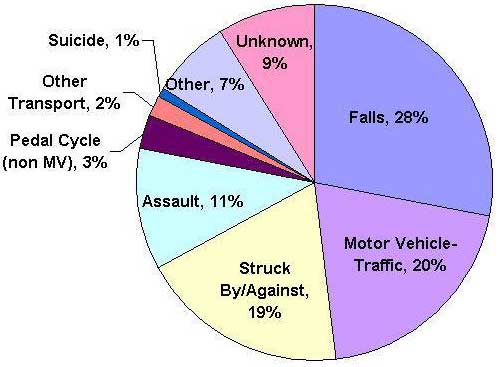Causes
A traumatic brain injury (TBI) is caused by a blow or jolt to the head or a penetrating head injury that disrupts the normal function of the brain.
The leading causes of TBI are:
- Falls (28%);
- Motor vehicle-traffic crashes (20%);
- Struck by/against events (19%); and
-
Assaults (11%).1

Falls
-
Falls are the leading cause of TBI; rates are highest for children ages 0 to 4 years and adults ages 75 years and older.1
Motor Vehicle-Traffic Crashes
- Motor vehicle-traffic causes result in the greatest number of TBI-related hospitalizations.1
-
The rate of motor vehicle-traffic-related TBI is highest among adolescents ages 15 to 19 years.1
Struck By/Against Events
- Struck by/against events, which include colliding with a moving or stationary object, are the third leading cause of TBI.
- Approximately 1.6 – 3.8 million sports- and recreation-related TBIs occur in the United States each year.2 Most of these are mild TBIs that are not treated in a hospital or emergency department.
Assaults
- Firearm use is the leading cause of death related to TBI.3
- Nine out of 10 people with a firearm-related TBI die.3
- Nearly two thirds of firearm-related TBIs are classified as suicidal in intent.3
Blasts are a leading cause of TBI for active duty military personnel in war zones.4
For more information on TBI and mass casualty events, go to http://www.bt.cdc.gov/masscasualties/injuryfactsheets.asp.
To learn more about the Defense and Veterans Brain Injury Center’s (DVBIC) efforts to prevent, treat, and provide education on TBI to active duty military, their dependents, and veterans, go to www.dvbic.org*.
References
- Langlois JA, Rutland-Brown W, Thomas KE. Traumatic brain injury in the United States: emergency department visits, hospitalizations, and deaths. Atlanta (GA): Centers for Disease Control and Prevention, Nation Center for Injury Prevention and Control; 2004.
- Langlois JA, Rutland-Brown W, Wald M. The epidemiology and impact of traumatic brain injury: a brief overview. Journal of Head Trauma Rehabilitation 2006;21(5):375-8.
- Centers for Disease Control and Prevention (CDC), National Center for Injury Prevention and Control. Traumatic brain injury in the United States—A report to Congress. Atlanta (GA): Centers for Disease Control and Prevention; 1999.
- Defense and Veterans Brain Injury Center (DVBIC). [unpublished]. Washington (DC): US Department of Defense; 2005.
Contact Us:
- Centers for Disease Control and Prevention
National Center for Injury Prevention and Control (NCIPC)
4770 Buford Hwy, NE
MS F-63
Atlanta, GA 30341-3717 - 800-CDC-INFO
(800-232-4636)
TTY: (888) 232-6348
24 Hours/Every Day - cdcinfo@cdc.gov

